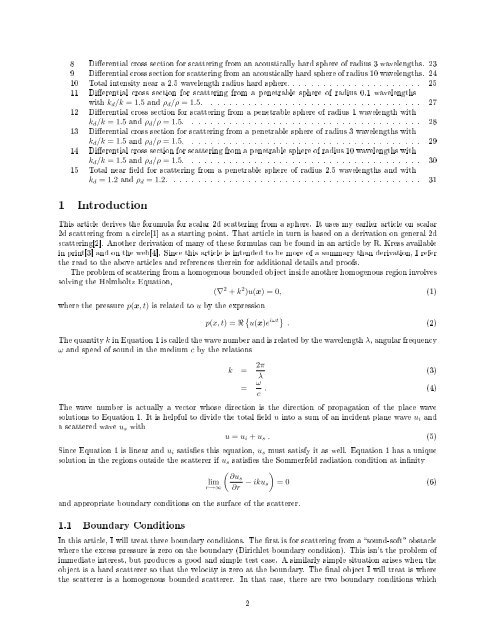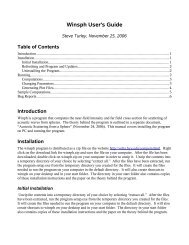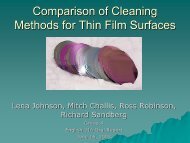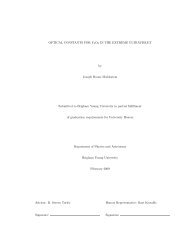Acoustic Scattering from a Sphere - Steve Turley
Acoustic Scattering from a Sphere - Steve Turley
Acoustic Scattering from a Sphere - Steve Turley
You also want an ePaper? Increase the reach of your titles
YUMPU automatically turns print PDFs into web optimized ePapers that Google loves.
8 Dierential cross section for scattering <strong>from</strong> an acoustically hard sphere of radius 3 wavelengths. 239 Dierential cross section for scattering <strong>from</strong> an acoustically hard sphere of radius 10 wavelengths. 2410 Total intensity near a 2.5 wavelength radius hard sphere. . . . . . . . . . . . . . . . . . . . . . 2511 Dierential cross section for scattering <strong>from</strong> a penetrable sphere of radius 0.1 wavelengthswith k d /k = 1.5 and ρ d /ρ = 1.5. . . . . . . . . . . . . . . . . . . . . . . . . . . . . . . . . . . 2712 Dierential cross section for scattering <strong>from</strong> a penetrable sphere of radius 1 wavelength withk d /k = 1.5 and ρ d /ρ = 1.5. . . . . . . . . . . . . . . . . . . . . . . . . . . . . . . . . . . . . . 2813 Dierential cross section for scattering <strong>from</strong> a penetrable sphere of radius 3 wavelengths withk d /k = 1.5 and ρ d /ρ = 1.5. . . . . . . . . . . . . . . . . . . . . . . . . . . . . . . . . . . . . . 2914 Dierential cross section for scattering <strong>from</strong> a penetrable sphere of radius 10 wavelengths withk d /k = 1.5 and ρ d /ρ = 1.5. . . . . . . . . . . . . . . . . . . . . . . . . . . . . . . . . . . . . . 3015 Total near eld for scattering <strong>from</strong> a penetrable sphere of radius 2.5 wavelengths and withk d = 1.2 and ρ d = 1.2. . . . . . . . . . . . . . . . . . . . . . . . . . . . . . . . . . . . . . . . . 311 IntroductionThis article derives the forumula for scalar 2d scattering <strong>from</strong> a sphere. It uses my earlier article on scalar2d scattering <strong>from</strong> a circle[1] as a starting point. That article in turn is based on a derivation on general 2dscattering[2]. Another derivation of many of these formulas can be found in an article by R. Kress availablein print[3] and on the web[4]. Since this article is intended to be more of a summary than derivation, I referthe read to the above articles and references therein for additional details and proofs.The problem of scattering <strong>from</strong> a homogenous bounded object inside another homogenous region involvessolving the Helmholtz Equation,(∇ 2 + k 2 )u(x) = 0, (1)where the pressure p(x, t) is related to u by the expressionp(x, t) = R { u(x)e iωt} . (2)The quantity k in Equation 1 is called the wave number and is related by the wavelength λ, angular frequencyω and speed of sound in the medium c by the relationsk = 2π λ(3)= ω c . (4)The wave number is actually a vector whose direction is the direction of propagation of the place wavesolutions to Equation 1. It is helpful to divide the total eld u into a sum of an incident plane wave u i anda scattered wave u s withu = u i + u s . (5)Since Equation 1 is linear and u i satises this equation, u s must satisfy it as well. Equation 1 has a uniquesolution in the regions outside the scatterer if u s satises the Sommerfeld radiation condition at innity( )∂uslimr→∞ ∂r − iku s = 0 (6)and appropriate boundary conditions on the surface of the scatterer.1.1 Boundary ConditionsIn this article, I will treat three boundary conditions. The rst is for scattering <strong>from</strong> a sound-soft obstaclewhere the excess pressure is zero on the boundary (Dirichlet boundary condition). This isn't the problem ofimmediate interest, but produces a good and simple test case. A similarly simple situation arises when theobject is a hard scatterer so that the velocity is zero at the boundary. The nal object I will treat is wherethe scatterer is a homogenous bounded scatterer. In that case, there are two boundary conditions which2





